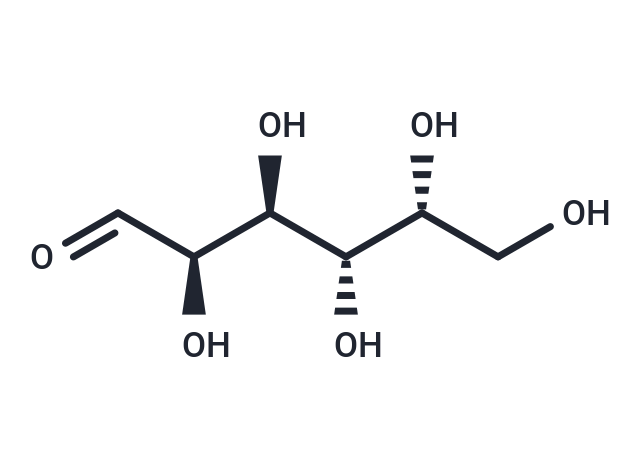Shopping Cart
Remove All Your shopping cart is currently empty
Your shopping cart is currently empty
D-Galactose is a naturally occurring hexose and a C-4 epimer of glucose. It can combine with glucose to form lactose and is commonly used to establish animal models of aging.

| Pack Size | Price | USA Warehouse | Global Warehouse | Quantity |
|---|---|---|---|---|
| 200 mg | $30 | In Stock | In Stock | |
| 500 mg | $42 | In Stock | In Stock | |
| 1 g | $50 | In Stock | In Stock | |
| 5 g | $68 | - | In Stock | |
| 1 mL x 10 mM (in DMSO) | $50 | In Stock | In Stock |
| Description | D-Galactose is a naturally occurring hexose and a C-4 epimer of glucose. It can combine with glucose to form lactose and is commonly used to establish animal models of aging. |
| In vitro | Galactose is important for the survival and virulence of bacteria. Galactose is utilized by the Leloir pathway in Escherichia coli. Two anomers of d-galactose are used for different purposes, α-d-galactose as a carbon source and β-d-galactose for induction of UDP-galactose synthesis for biosynthetic glycosylation[1]. |
| In vivo | Chronic D-galactose exposure induces neurodegeneration by enhancing caspase-mediated apoptosis and inhibiting neurogenesis and neuron migration in mice, as well as increasing oxidative damage. Moreover, D-galactose-induced toxicity in mice is a useful model for studying the mechanisms of neurodegeneration and neuroprotective drugs and agents[2]. D-galactose given by oral route leads to cognitive impairments in rats which are accompanied by oxidative damage. Cognitive impairments is observed in the open-field test in the 4th and 6th weeks after d-gal administration, as well as an impairment in spatial memory in the radial maze test after the 6th week of d-gal administration[3]. |
| Synonyms | D-Galactopyranose, D-(+)-Galactose, Alpha-D-galactose |
| Molecular Weight | 180.16 |
| Formula | C6H12O6 |
| Cas No. | 59-23-4 |
| Smiles | [C@@H]([C@@H]([C@H](C=O)O)O)([C@@H](CO)O)O |
| Relative Density. | 1.5 g/cm3 |
| Color | White |
| Appearance | Solid |
| Storage | Powder: -20°C for 3 years | In solvent: -80°C for 1 year | Shipping with blue ice/Shipping at ambient temperature. | |||||||||||||||||||||||||||||||||||
| Solubility Information | H2O: 66 mg/mL (366.34 mM), Sonication is recommended. DMSO: 86.6 mg/mL (480.68 mM), Sonication is recommended. | |||||||||||||||||||||||||||||||||||
| In Vivo Formulation | 10% DMSO+40% PEG300+5% Tween 80+45% Saline: 3.3 mg/mL (18.32 mM), Sonication is recommended. Please add the solvents sequentially, clarifying the solution as much as possible before adding the next one. Dissolve by heating and/or sonication if necessary. Working solution is recommended to be prepared and used immediately. The formulation provided above is for reference purposes only. In vivo formulations may vary and should be modified based on specific experimental conditions. | |||||||||||||||||||||||||||||||||||
Solution Preparation Table | ||||||||||||||||||||||||||||||||||||
H2O/DMSO
| ||||||||||||||||||||||||||||||||||||
| Size | Quantity | Unit Price | Amount | Operation |
|---|

Copyright © 2015-2025 TargetMol Chemicals Inc. All Rights Reserved.